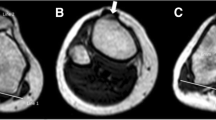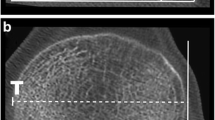Abstract
Purpose
Since excessive tibial tuberosity–trochlear groove distance (TT–TG) is one of the major risk factors for patellofemoral instability, TT–TG is an often-used parameter in knee realignment surgery. Up to date, TT–TG is measured and interpreted using absolute values, disregarding the knee size of the individual. It was hypothesized that there is a relation between TT–TG and knee size and body height, respectively.
Methods
Consecutive MRI scans of 120 knee joints were analysed retrospectively. Of these, 60 MRI scans were obtained from patients with trochlear dysplasia and another 60 MRI scans were acquired from patients presenting with a different pathology of the knee joint. TT–TG was measured and TD was classified into low and high grade. Interepicondylar distance as an expression of knee size was measured on transverse MRI slices presenting the maximal distance from the medial to the lateral epicondylus. TT–TG was correlated with interepicondylar distance and body height.
Results
Interepicondylar distance as an expression of knee size correlated highly with body height in the control group with normal trochlea (r = 0.78) as well as in the TD group (r = 0.69). Correlation of TT–TG with interepicondylar distance or body height in the control group as well as in the TD group showed poor values with r < 0.30 (range r = 0.072–0.28).
Conclusion
TT–TG seems associated neither with the size of the individual knee, nor with body height. For this reason, TT–TG has to be considered as very individual parameter in knee realignment surgery.



Similar content being viewed by others
References
Balcarek P, Jung K, Frosch KH, Stürmer KM (2011) Value of the tibial tuberosity-trochlear groove distance in patellar instability in the young athlete. Am J Sports Med 39(8):1756–1761
Camp CL, Stuart MJ, Krych AJ, Levy BA, Bond JR, Collins MS, Dahm DL (2013) CT and MRI measurements of tibial tubercle-trochlear groove distances are not equivalent in patients with patellar instability. Am J Sports Med 41(8):1835–1840
Dejour D, Saggin P (2010) The sulcus deepening trochleoplasty—the Lyon’s procedure. Int Orthop 34(2):311–316
Dejour H, Walch G, Nove-Josserand L, Guier CH (1994) Factors of patellar instability: an anatomic radiographic study. Knee Surg Sports Traumatol Arthrosc 2:19–26
Dietrich TJ, Betz M, Pfirrmann CW, Koch PP, Fucentese SF (2014) End-stage extension and its influence on the tibial tuberosity-trochlear groove distance (TTTG) in asymptomatic volunteers. Knee Surg Sports Traumatol Arthrosc 22(1):214–218
Goutallier D, Bernageau J, Lecudonnec B (1978) The measurement of the tibial tuberosity-patella groove distanced technique and results (author’s transl). Rev Chir Orthop Reparatrice Appar Mot 64(5):423–428
Izadpanah K, Weitzel E, Vicari M, Hennig J, Weigel M, Suedkamp NP, Niemeyer P (2014) Influence of knee flexion angle and weight bearing on the tibial-tuberosity-trochlear groove (TTTG) distance for evaluation of patellofemoral alignment. Knee Surg Sports Traumatol Arthrosc 22(11):2655–2661
Koeter S, Diks MJF, Anderson PG, Wymenga AB (2007) A modified tibial tubercle osteotomy for patellar maltracking. J Bone Joint Surg Br 89(2):180–185
McNally EG, Osterle SJ, Pal C (2000) Assessment of patellar maltracking using combined static and dynamic MRI. Eur Radiol 10:1051–1055
Pandit S, Frampton C, Stoddart J, Lynskey T (2001) Magnetic resonance imaging assessment of tibial tuberosity-trochlear groove distance: normal values for males and females. Int Orthop 35(12):1799–1803
Pennock AT, Alam M, Bastrom T (2014) Variation in tibial tubercle-trochlear groove measurement as a function of age, sex, size and patellar instability. Am J Sports Med 42(2):389–393
Schoettle PB, Zanetti M, Seifert B, Pfirrmann CW, Fucentese SF, Romero J (2006) The tibial tuberosity-trochlear groove distance; a comparative study between CT and MRI scanning. Knee 13(1):26–31
Shelbourne KD, Kerr B (2001) The relationship of femoral intercondylar notch width to height, weight and sex in patients with intact anterior cruciate ligaments. Am J Knee Surg 14(2):92–96
Tecklenburg K, Feller JA, Whitehead TS, Webster KE, Elzarka A (2010) Outcome of surgery for recurrent patellar dislocation based on the distance of the tibial tuberosity to the trochlear groove. J Bone Joint Surg Br 92(10):1376–1380
Wittstein JR, Bartlett EC, Easterbrook J, Byrd JC (2006) Magnetic resonance imaging evaluation of patellofemoral malalignment. Arthroscopy 22(6):643–649
Conflict of interest
None.
Author information
Authors and Affiliations
Corresponding author
Rights and permissions
About this article
Cite this article
Dornacher, D., Reichel, H. & Kappe, T. Does tibial tuberosity–trochlear groove distance (TT–TG) correlate with knee size or body height?. Knee Surg Sports Traumatol Arthrosc 24, 2861–2867 (2016). https://doi.org/10.1007/s00167-015-3526-7
Received:
Accepted:
Published:
Issue Date:
DOI: https://doi.org/10.1007/s00167-015-3526-7




